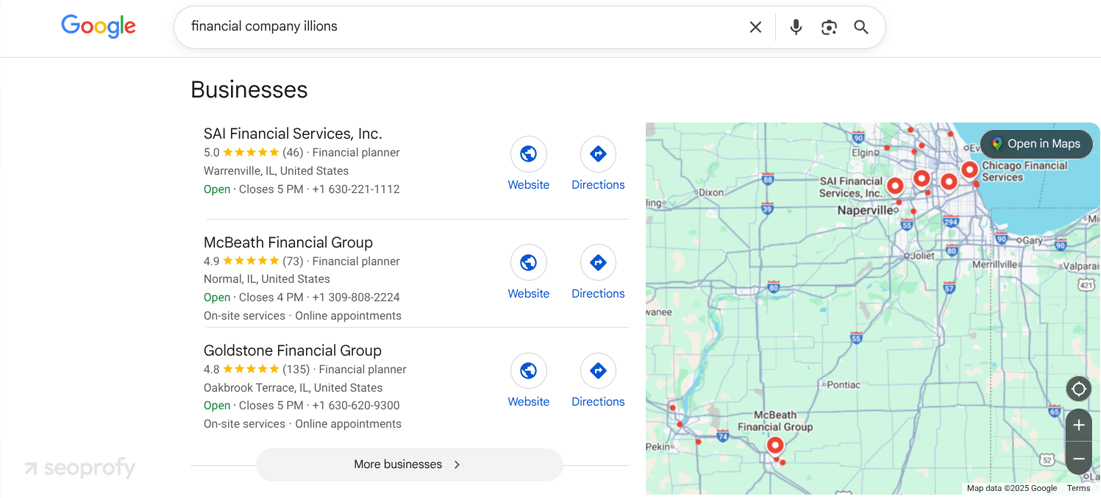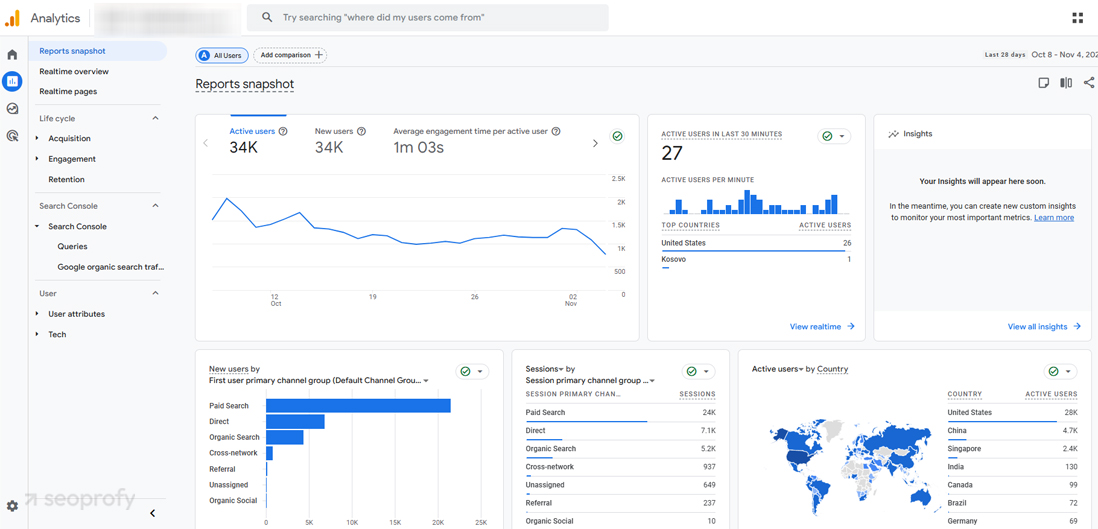SEO for financial services involves methods to improve website rankings for relevant keywords, such as “wealth manager near me” or “best insurance company.” This process requires a thorough integration of high-quality content creation, technical optimization, link building, and other efficient techniques.
Furthermore, you need to consider the particularities of your business and audience to tailor all the mentioned SEO methods to your specific needs. In our guide, you’ll find valuable tips that highlight how this or that technique can get you closer to your success on the financial market.
- Following the YMYL and E-E-A-T standards is essential when crafting content on financial topics.
- Security is one of the most important factors to consider in on-page SEO for financial institutions.
- Businesses in the financial sector can reach 1,031% ROI from SEO.
- Focusing on keywords with medium KD and search volume can help you overcome tough competition in the market.
What Is Special About the SEO Approach in Financial Websites
If you want your digital marketing campaign to succeed, it’s essential to opt for an SEO agency that already has experience in working with the financial services industry. There are significant differences between traditional search engine optimization and the approach for your niche:
|
Traditional SEO |
SEO for a Financial Niche |
|
| Key Goal | Drive organic traffic and increase online rankings. | Build trust, attract interested clients, and ensure compliance. |
| Keyword strategy | Primary aims for high-volume keywords. | The content should strike a balance between keywords with high search volume and specific long-tail queries to drive conversions. |
| Content strategy | Prioritizes blog posts that increase user engagement. | Involves creating verifiable educational content to help clients understand complex financial topics. |
| Technical SEO | Mainly focuses on features such as site speed, indexing, and crawlability. | In addition to traditional features, it includes enhanced security measures such as HSTS and CSP to protect sensitive user data. |
| Regulation and compliance | Not a primary concern. | Content must strictly adhere to regulations from the SEC, FINRA, and the FCA, as well as Google’s YMYL guidelines. |
| Metrics | Organic traffic, rankings, and conversions. | In addition to traditional metrics, financial SEO considers the trust a business has with its audience. |
Main Challenges of SEO for Financial Services
SEO strategies for financial services can help you overcome a variety of challenges you may face while running your business. By employing a professional approach and conducting thorough analysis, you will be able to address the following challenges:
- Strict compliance reviews: Your content about financial topics must not only be SEO-friendly but also truthful and backed by real-life data. Further, your blog posts may be oriented towards the audience without specific knowledge. Thus, it’s important to reveal complex topics in a way that is understandable for any potential client.
- YMYL and E-E-A-T standards: It’s essential to follow Google’s experience, expertise, authoritativeness, and trustworthiness (E-E-A-T) standards, mainly when you craft content that impacts the financial stability of people. Further, if you manage to create a helpful blog post on “Your Money or Your Life” (YMYL) topics, there is a strong chance that algorithms will rank it high on SERPs.
- Competition: It’s challenging for newcomers to climb the ranks due to the large number of websites in this niche, including fintech products, financial platforms, and more. Only with proper analysis can you identify sectors with lower competition levels to start building your brand, gradually increasing its authority and online visibility.
- AI-friendly content: Modern users increasingly use platforms like ChatGPT to search for information and conduct research. Through a proper LLM SEO campaign and optimized content, you can make your services appear in the AI-generated recommendations, increasing the number of visitors and the brand’s overall online visibility.
Why SEO Makes Sense for Financial Websites
According to our SEO ROI statistics, financial services is the second niche with the highest return on investment (1,031%) from search engine optimization. In addition to the growth of your revenue, professional financial services SEO can help you hit the following business goals:
- Attract high-qualified traffic
- Boost brand awareness in local and national markets
- Stand out from the competitors
SEO strategies for financial services primarily focus on crafting trustworthy content and improving your user experience by optimizing website elements and the navigation system. After these enhancements, you’ll create a smooth customer journey that lets visitors discover your services, learn about their benefits, and ultimately become your loyal clients. Unlike paid ads, SEO delivers long-lasting results beyond the end of your campaign.
How to Make SEO for Financial Services Companies: Essential Strategies
The choice of financial services SEO techniques depends on your business goals, the specificities of the target audience, and your competitors. Nonetheless, to achieve the best results and the highest ROI, it’s better to opt for a bundle of time-tested solutions listed below.

SEO Strategy Foundation: Audit & Research
The development of an efficient financial website SEO strategy must undoubtedly start with a thorough analysis of the following elements:
- Current condition: Estimate the performance of your pages and blog posts using tools like Screaming Frog, Google Analytics, and Google Search Console. Pay attention to the time people spend on your site and the types of content that drive the most organic traffic to identify the key areas for improvement.
- Target audience: You can’t develop an effective strategy for financial SEO without considering your potential clients’ pain points and preferences. Plus, always review your audience’s feedback and frequently asked questions, as they can serve as ideas for your future blog posts, guides, and educational content.
- Competitors: Analyzing your competitors’ websites and content is a great way to understand which content drives the most traffic and identify valuable keywords. You can also spot content gaps and use them to overcome your competitors in ranking for specific search queries.
During this stage, you’ll need to build a core set of keywords. Targeting the right search queries is essential to reach the audience that is genuinely interested in your financial services.
You can identify relevant keywords using popular platforms like Semrush and Ahrefs. It’s a good idea to group the discovered terms by keyword difficulty. For example, as you can see, the keyword “business credit cards” has a significant search volume and traffic potential, but its KD is 53, which means it’ll be challenging to rank for it:

It’ll be unreasonable to immediately aim for such keywords, especially if you run a new financial website due to low domain authority, a poor backlink profile, and other issues. First, focus on long-tail terms with lower KD but still substantial search volume and traffic potential:

Crafting High-Quality, Compliant Content
Hitting high ranks and establishing strong brand authority are impossible without creating high-quality content that addresses your clients’ pain points. When it comes to writing blog posts and guides in the financial industry, stick to the following rules:
- Enhance your blog posts with quotes from the financial industry leaders and verifiable data (ideally no older than two years) to back up your statements.
- Properly add the internal links to other high-quality content and your financial services in your blog post. Show the audience how to overcome their specific challenges with your solutions, gradually inspiring them to make a purchase or book a consultation.
- Don’t try to cover everything in one article to avoid overwhelming your readers with tons of information. Instead, focus on creating targeted content that addresses each of your clients’ needs individually.
It’s essential to review each article, blog post, or guide to ensure it follows the E-E-A-T principles. The table below provides some examples you can use to generate proper content:
|
E-E-A-T principle |
Explanation |
Examples |
| Experience | Demonstrate hands-on experience with the financial products or services and knowledge gained from working on real projects. |
|
| Expertise | Display your in-depth knowledge of specific financial topics, backed by credentials and data from related research. |
|
| Authoritativeness | Build your reputation in the financial industry by consistently publishing high-quality content referenced by other authoritative sources. |
|
| Trustworthiness | Ensure that your content is accurate, transparent, and honest. |
|
A proper financial services SEO campaign also involves regular monitoring of your content performance. Monitor the audience’s interaction with your blog posts and landing pages by tracking metrics like bounce rate and conversions.
On-Page SEO and Technical Optimization
Dozens of our successful case studies show that a successful SEO campaign must involve improving on-page elements to make the website page more search engine-friendly. Your task is to strategically incorporate the target keywords into both your content and the following elements:
- Headings: H1, H2, and H3 tags will help you structure your content, making it easier for algorithms and visitors to understand its context.
- URL slug: A properly optimized URL slug helps users understand what your page is about and provides search bots with context, improving its rankings and visibility.
- Alt text: It’s crucial to prepare image descriptions for all visual content on your site to boost its SEO and accessibility.
- Metadata: Meta titles and descriptions are the first thing a person sees when they come across your page in SERPs. Ensure that these elements include proper keywords and inspire potential clients to visit your website. Consider that it’s better to keep the meta description within 150 characters, just like in the example below:

In addition to enhancing the mentioned elements, proper on-page SEO in financial services also involves more advanced techniques. The most efficient of them include:
- Improvement of internal links: This process involves reviewing them to ensure there are no broken links, which can affect your website rankings and overall user experience.
- Schema markup optimization: Properly adjusting this code will provide search algorithms with contextual information about your content. Thus, they’ll better understand and categorize your pages.
- Side speed improvement: A page load time of under 3 seconds is considered a satisfactory result. In the other case, a user is likely to leave your website. You can check the performance of your website with the help of free tools like PageSpeed Insights.
- Mobile optimization: Search engines follow the mobile-first indexing principle, which means they prioritize your website’s mobile version when ranking it.
- Security enhancement: The website operating in the financial niche must ensure top-notch protection of its users’ data through advanced HTTPS protocols.
Grow your credibility and client list with our SEO for financial services:
- Custom strategies
- ROI-oriented solutions
- Data-driven approach
- Regular monitoring

Local SEO: Tap Into Regional Audiences
If your company has a brick-and-mortar office, focusing on local SEO is a must to overcome competition in your operating region. Furthermore, if you try to cover multiple locations, it’s essential to create individual pages for each of them, focusing on local keywords and trends. Incorporating them in your content will help you increase organic traffic and boost your rankings in specific regions.
During your local financial services SEO campaign, you must also optimize the Google Business Profile of each physical office. Check whether it contains up-to-date information about your company and services. Furthermore, don’t forget to respond to all user reviews to show both potential clients and algorithms that you take your audience’s feedback seriously. This approach, combined with a high rating on Google Maps, increases your chances of getting into the Google 3-Pack:

Link Building and Off-Page SEO
If you want to boost your authority and trustworthiness, including link building in your SEO strategy is the best decision you can make. Getting references from reputable online news websites, financial magazines, and local listings offers an excellent opportunity to grow your reputation.
It’s important to avoid any black-hat tactics while building your backlink profile if you don’t want to get Google penalties. At the same time, you can opt for techniques focused on attracting references from relevant sources:
- Link baiting: Focus on the creation of the content that other people want to link to. It may be interactive tools like financial calculators, statistics, and reports.
- Skyscraper technique: Check the most popular content on the topic you’re going to reveal and create a better version by providing additional information and diving deeper into complex questions. Thus, people may start referring to your article, providing you with valuable backlinks.
- Unlinked mentions: Monitor media to discover any unlinked mentions of your brand. Then, contact the web masters of such online resources and ask them to add a link to your site.
- Digital PR: Using platforms like Connectively and Prowly, you can find media requesting expert opinion on various financial topics. If you manage to submit your insights successfully, you’re likely to receive a backlink and enhance your online authority.
You should also regularly check your backlink profile using tools like Ahrefs or Backlinko to identify broken backlinks. Once you do it, reach out to the webmasters, asking to replace old references with functional ones.
Using Reviews and Reputation Management
Review management is among the key essential strategies for financial services that have the biggest impact on consumer trust and your website’s authority. At the same time, Google not only considers your clients’ feedback but also how you respond to it. Therefore, to achieve algorithm recommendations, adhere to the following principles:
- Always respond politely and quickly to both negative and positive reviews.
- Inspire your clients to leave feedback through a business link or QR code.
- Avoid buying fake reviews since this activity violates Google rules.
Keeping a good reputation on Google Maps and other platforms is important, as your clients are likely to conduct comprehensive research before opting for your services. Further, if you want your financial business to rank on ChatGPT and other AI-powered platforms, you should also keep your online reputation high. When deciding whether to recommend your services or products, its algorithms will consider your brand’s online reviews, mentions, topical authority, and relevancy of your content.
Tracking & Measuring SEO Performance
The implementation of financial services SEO isn’t a sprint but a marathon, so even after improving your website performance, it’s still important to keep an eye on it. To stay ahead of the curve, track these metrics regularly, as trends and algorithms change:
- Keyword rankings
- Organic traffic
- Conversions and engagement
- Number of backlinks
- Local listing performance
You can use tools, such as Ahrefs and Semrush, to keep track of your website performance. Additionally, free software such as Google Analytics can provide you with valuable insights:

Overcoming Implementation Challenges
Strict YMYL and E-E-A-T standards and tough competition are the core challenges in SEO for financial services. Further, you may also face problems like
- Lack of knowledge: Your inner team may be simply unable to perform all the mentioned strategies effectively.
- Outdated technologies: The absence of necessary SEO tools, slow CMS, and legacy systems may prevent you from delivering a pleasant user experience.
- Lack of collaboration: It’s important to align the work of all your departments. For example, writers must closely collaborate with their financial experts to craft high-quality, authoritative content.
That’s where you may need to opt for third-party assistance. By collaborating with a professional financial SEO company, you can focus on your core business tasks while your partners will take care of your website and online authority. Thus, you’ll save not only your time but also money that you might have spent on a subscription to software for search engine optimization. Further, you’ll avoid making beginner mistakes, which may cost you not only your resources but also your brand’s reputation.
Financial SEO Trends: 2025 and Beyond
It is important to consider the latest trends if you want to craft essential SEO strategies for financial services websites. Here, we’ve prepared a list of the tendencies to follow when boosting your visibility and rankings:
- AI-driven searches: According to ChatGPT statistics, this platform may surpass a 1% share threshold of the search market by the end of 2025. It’s a clear indicator that more and more people use it and other AI-powered platforms to search for information, services, and products.
- Voice search optimization: Due to the rising popularity of voice assistants, search algorithms shift toward natural, spoken queries. This trend opens a possibility of reaching new audiences by implementing long-tail keywords into relevant content.
- Answer engine optimization: Answer engines also gain popularity as they provide users with direct answers. Opting for advanced AEO techniques is a smart decision that can make your pages appear in AI Overviews.
- Omni-channel digital presence: Modern financial businesses must go far beyond Google search results. Staying active on YouTube, TikTok, and other social media is also important for growing your business.
Financial SEO Strategy that Works
SEO for financial services is a real game-changer, which can turn your local business into a strong national brand. Often, it’s necessary to implement all the mentioned techniques, consider emerging brands, and account for your audience’s particularities to grow organic traffic and drive conversions. Further, if you want to rank in AI Overviews and get into Google 3-Pack, you’ll also need to properly manage your clients’ reviews.
Of course, dealing with all the mentioned tasks may feel overwhelming, considering you still have to provide high-quality financial services or products. Luckily, you can rely on SeoProfy, and together we’ll reach the top of the SEO pyramid.













